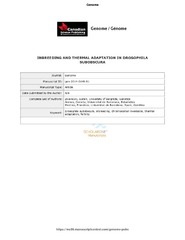Приказ основних података о документу
Inbreeding and thermal adaptation in Drosophila subobscura
| dc.creator | Živanović, Goran | |
| dc.creator | Arenas, Conxita | |
| dc.creator | Mestres, Francesc | |
| dc.date.accessioned | 2016-05-23T11:00:24Z | |
| dc.date.issued | 2014 | |
| dc.identifier.issn | 1480-3321 | |
| dc.identifier.uri | https://radar.ibiss.bg.ac.rs/handle/123456789/2161 | |
| dc.description.abstract | Using a well-adapted Drosophila subobscura population (Avala, Serbia), a drastic experiment of inbreeding was carried out to assess whether the expected level of homozygosity could be reached or if other evolutionary forces affected the process. In general, no significant changes of inversion (or arrangement) frequencies were detected after 12 brother-sister mating generations. Furthermore, no significant differences were obtained between observed and expected (under the inbreeding model) karyotypic frequencies. Thus, these results seemed to indicate that the main evolutionary factor in the experiment was inbreeding. However, in the G(12) generation, complete chromosomal fixation was reached only in two out of the eight final inbred lines. In these lines, the chromosomal compositions were difficult to interpret, but they could be likely a consequence of adaptation to particular laboratory conditions (constant 18 degrees C, food, light period, etc.). Finally, in a second experiment, the inbred lines presented higher fertility at 18 degrees C than at 13 degrees C. Also, there was a significant line effect on fertility: inbred line number 6 (A(1), J(1), U(1) under bar+(2) under bar; U(1) under bar+(2) under bar+(6) under bar, E-8, and O (3) under bar (+(4) under bar+(7) under bar)) presented the highest values, which maybe the result of an adaptation to laboratory conditions. Thus, the results obtained in our experiments reflect the adaptive potential of D. subobscura inversions. | en |
| dc.description.sponsorship | Ministry of Education, Science and Technological Development of the Republic of Serbia {[}173025]; Ministerio de Economia y Competitividad (Spain) {[}CTM2013-48163-C2-2-R]; Generalitat de Catalunya (Spain) {[}2014 SGR 336, 2014 SGR 464] | |
| dc.language | English | |
| dc.rights | openAccess | |
| dc.source | Genome | |
| dc.subject | Drosophila subobscura | |
| dc.subject | inbreeding | |
| dc.subject | chromosomal inversions | |
| dc.subject | thermal adaptation | |
| dc.subject | fertility | |
| dc.title | Inbreeding and thermal adaptation in Drosophila subobscura | en |
| dc.type | article | |
| dc.rights.license | ARR | |
| dcterms.abstract | Местрес, Францесц; Зивановиц, Горан; Aренас, Цонxита; | |
| dc.rights.holder | © 2015 Published by NRC Research Press. | |
| dc.citation.issue | 9 | |
| dc.citation.volume | 57 | |
| dc.description.note | This is the peer reviewed version of the following article: Zivanovic G, Arenas C, Mestres F. Inbreeding and thermal adaptation in Drosophila subobscura. Genome. 2014 Sep;57(9):481–8. [https:://doi.org/10.1139/gen-2014-0149] | |
| dc.identifier.doi | 10.1139/gen-2014-0149 | |
| dc.identifier.scopus | 2-s2.0-84964247825 | |
| dc.identifier.wos | 000349229200003 | |
| dc.citation.spage | 481 | |
| dc.citation.epage | 488 | |
| dc.type.version | acceptedVersion | en |
| dc.identifier.fulltext | https://radar.ibiss.bg.ac.rs/bitstream/id/5702/646475.pdf |

